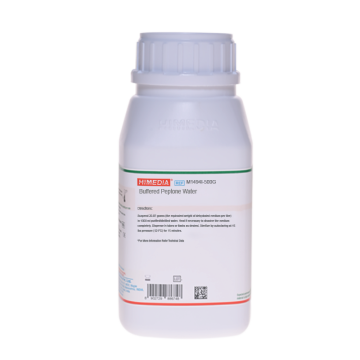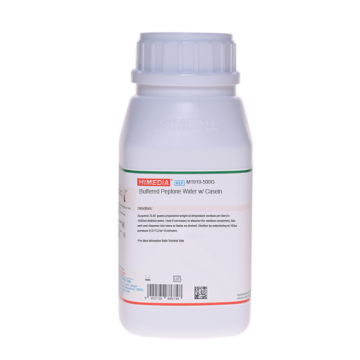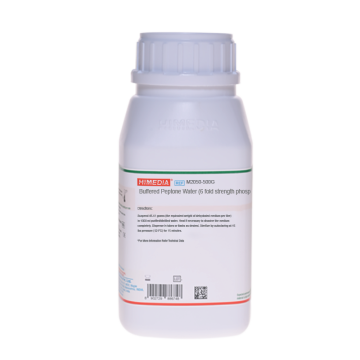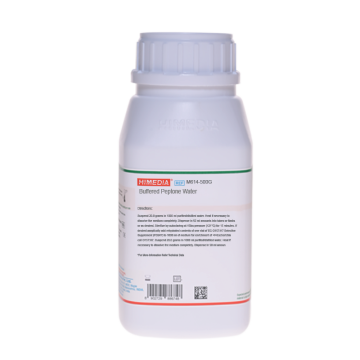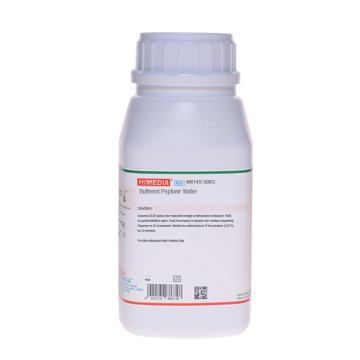 Your enquiry has been submitted
Your enquiry has been submitted
Modified Universal Pre-enrichment Broth
Modified Universal Pre-enrichment Broth
M1372F
Modified Universal Pre-enrichment Broth is used for recovering Salmonella and Listeria from food in accordance with FDA BAM, 1998.
Composition**
Ingredients
| Ingredients | Gms / Litre |
|---|---|
| Tryptone | 5.000 |
| Proteose Peptone | 5.000 |
| Monopotassium Phosphate | 15.000 |
| Disodium Phosphate | 7.000 |
| Sodium Chloride | 5.000 |
| Dextrose | 0.500 |
| Magnesium sulphate | 0.250 |
| Sodium Pyruvate | 0.200 |
| Final pH (at 25°C) | 6.3±0.2 |
**Formula adjusted, standardized to suit performance parameters
Directions
Suspend 37.95 grams in 1000 ml distilled water. Heat if necessary, to dissolve the medium completely. Sterilize by autoclaving at 15 lbs pressure (121°C) for 15 minutes. Mix well and dispense as desired.
Principle And Interpretation
Modified Universal Pre-enrichment Broth is used in the isolation of Salmonellae and Listeria from mamey pulp, in accordance with FDA BAM (1). Environmental stress induces sublethal injury or metabolic damage to microbial cells. Recovery of such cells from food and other products is achieved by growing those cells in an enrichment media prior to isolation on selective media (2). Injury to these cells, especially from food products may be a result of processing and handling methods, including thermal treatment, refrigeration, freezing, drying and irradiation or from exposure to preservatives, acidity or low water activity. Enrichment broths normally either contain antibiotics or are not sufficiently buffered to support injured bacteria (3,4). Modified Universal Pre-enrichment Broth is different from others that this medium is sufficiently buffered to support the growth of injured bacteria and that it do not contain antibiotics. This has a composition similar to that of Universal Pre enrichment broth (M1372) formulated by Bailey and Cox (5) omitting Ferric Ammonium Citrate.
Casein enzymic hydrolysate and proteose peptone serve as sources of carbon, nitrogen, vitamins and minerals. Dextrose serves as the source of energy. Phosphates buffer the medium. Magnesium sulphate and sodium chloride provide essential ions required for metabolism. Sodium pyruvate stimulates the metabolism of injured organisms.
Quality Control
Appearance Light yellow to beige homogeneous free flowing powder
Colour and Clarity of prepared medium Light amber coloured clear to slightly opalescent solution that may have a slight precipitate
Reaction Reaction of 3.8% w/v aqueous solution at 25°C. pH: 6.3±0.2
pH 6.10-6.50
Cultural Response Cultural characteristics observed after an incubation at 35-37°C for 18-24 hours.
Cultural Response
| Organism | Inoculum (CFU) | Growth |
|---|---|---|
| Listeria monocytogenes ATCC 19118 | 50-100 | good |
| Salmonella Enteritidis ATCC 13076 | 50-100 | good |
| Salmonella Typhimurium ATCC 14028 | 50-100 | good |
Storage and Shelf Life
Store below 30°C in tightly closed container and prepared medium at 2-8°C. Use before expiry date on the label.
Reference
- FDA US.Bacteriological Analytical Manual. 8 ed. Gaithersburg, Md.: AOAC International; 1998.
- Downes FP, Ito K, editors. Compendium of Methods For The Microbiological Examination of Foods. 4 ed. Washington, D.C.: APHA; 2001.
- Bailey JS, Fletcher DL, Cox NA. J Food Prot. 1990;53:473-7.
- Juven BJ, Cox NA, Bailey JS, Thomson JE, Charles OW, Shutze JV. J Food Prot. 1984;47:299-302.
- Bailey JS, Cox NA. J Food Prot. 1992;55:256-9.
| Product Name | Modified Universal Pre-enrichment Broth |
|---|---|
| SKU | M1372F |
| Product Type | Regular |
| Physical Form | Powder |
| Origin | Animal |
| Packaging type | HDPE |
| References | 1. Downes F. P. and Ito K., (Ed.), 2001, Compendium of Methods for the Microbiological Examination of Foods, 4th Ed.,American Public Health Association, Washington, D.C. |
| Customized Product Available | No |






